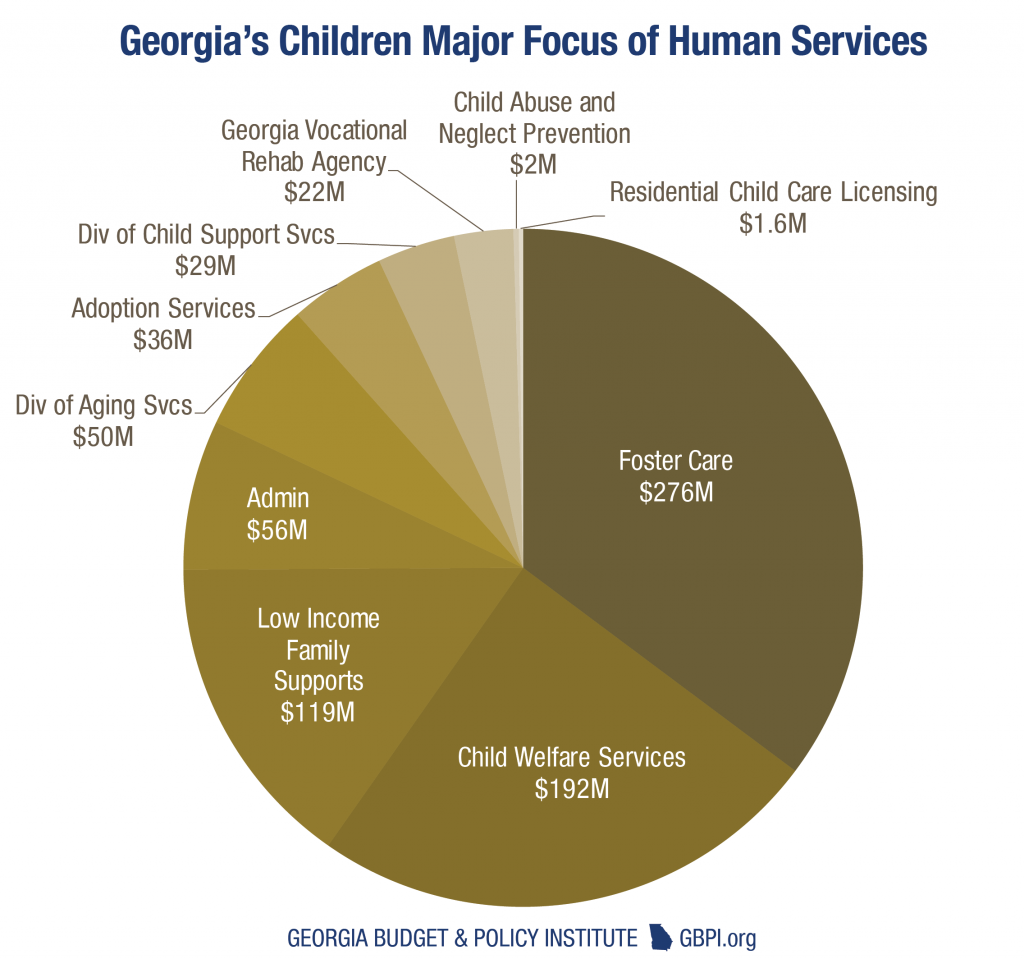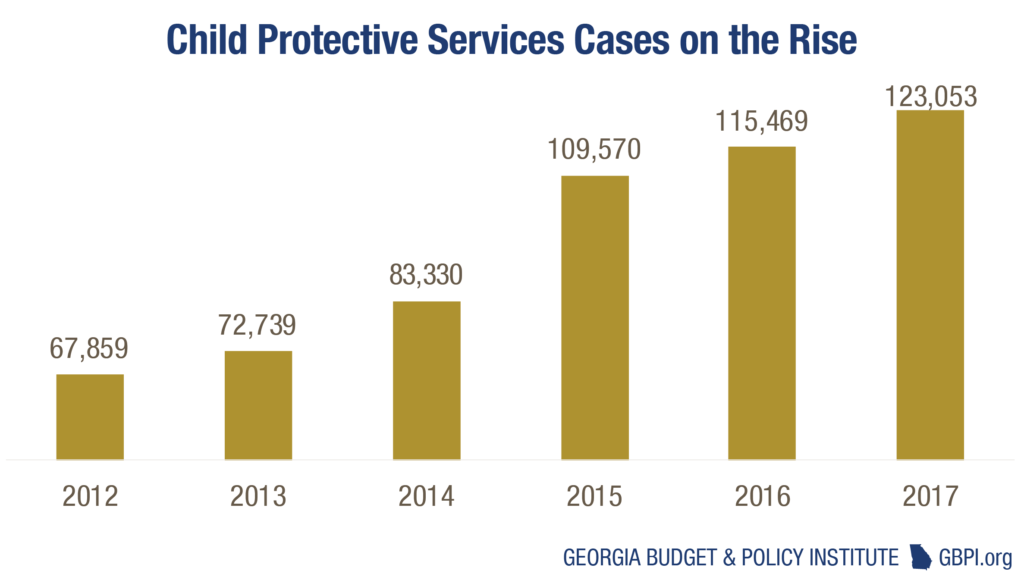Human Services Budget Overview
Georgia’s Department of Human Services oversees state spending to protect children and the elderly as well as provide non-medical assistance to people with low incomes. State funding for the agency is $797 million in 2019, about 3 percent of total state spending.
Child welfare-related services represent the largest share of the department’s responsibilities, accounting for $507 million, or 63 percent, of the department’s 2019 budget. These services include protecting children from abuse, abandonment and neglect, as well as safeguarding them in suitable temporary and permanent homes.
About $129 million of the Human Services budget helps low-income families gain access to Temporary Assistance for Needy Families, nutrition assistance, Medicaid and other federal services. These temporary supports help children stay healthy and help keep adults prepared for job opportunities, putting them on a path to financial independence.
Other Human Services functions protect and sustain older Georgians, enforce parents’ responsibility to financially support their children and help people with disabilities get jobs. Human Services employees also license, monitor and inspect temporary foster homes.

Child Welfare: Growing Resources for System Trauma
The Child Welfare portion of the Human Services budget, $194 million, pays the salaries of staff who investigate allegations of child abuse, abandonment and neglect.
The 2019 budget includes $980,000 more for child advocacy centers. That will support an increase in equipment and therapeutic, medical, and outreach services. These centers coordinate with the department in the investigation of child abuse and offer abuse prevention education for professionals and adults.
Reports of child abuse nearly doubled in Georgia in recent years, to 123,000 in 2017 from 67,859 in 2012.
The budget also allots $2.2 million for 19 care coordinator positions for foster youth. This follows a recommendation by Georgia’s Commission on Children’s Mental Health to extend access to services for children dealing with social-emotional trauma in the foster care system.
Recommendations from the governor’s Child Welfare Reform Council prompted the division to improve retention and recruitment of child welfare workers to ease the high caseloads that exceeded recommended industry standards of 15 cases per worker. The division reported in 2018 it filled more than 700 positions, increased base salaries, and reduced the average caseload per worker to 19 from 38.

Foster Care Gets Boost as Child Abuse Reports Rise
Foster families, child placement agencies and child care institutions, or group homes, are allotted $15.1 million more in the 2019 state budget to keep pace with growth in foster care. Georgia’s opioid crisis is cited as one of the largest culprits causing the growth in the number of children placed in foster care. From December 2016 to February 2018, the number of children in foster care grew 11.1 percent.
In 2018, the governor and lawmakers increased per-diem rates $10 for foster families recruited directly by the Division of Family and Child Services. The additional money is meant to ensure foster families can support children in their care and to bring Georgia’s rates more in line with other states. Also in 2018, relatives caring for foster children and families served through private agencies received an increase of $5 per day. The 2019 budget adds $20.3 million to increase per-diem rates by an additional $5 for these two types of foster families.
The budget also includes $2.4 million more for a 2.5 percent per-diem rate increase for child-caring institutions, or group homes. Child placement agencies also received $1.1 million to cover increased administrative costs.
The state intends to reimburse a family that cares for a foster child from $25 to $30 per day, depending on the age of the child and the type of placement. This is designed to cover food, shelter, clothing, basic supervision and oversight.

Shrinking Low-Income Support Creates Hardship
Georgians still struggle in many pockets of the state with unemployment, jobs offering low wages and fewer hours than they are willing to work, or simply a scarcity of quality job opportunities. The Department of Human Services 2019 budget includes $129 million to pay the salaries of hundreds of state employees who administer federal safety-net programs that provide a base level of support for people until they get back on their feet and into the workforce.
In some ways the landscape for support is shrinking in Georgia. A growing number of counties now limit the length of time childless adults can receive food assistance. In the years since the Great Recession ended, Georgia gradually increased the number of counties where childless adults are required to find a job within three months of receiving food assistance. This can create hardship in the many Georgia counties still coping with high unemployment and job scarcity. These challenges may lead to greater demand for low-income supports and require that Georgia add additional case workers to administer benefits or help participants find work.

Substantial Need Remains for Child Care Assistance
Bright from the Start, also known as Georgia’s Department of Early Care and Learning, provides access to quality child care for families that earn low incomes. Parents who receive child care assistance generally experience fewer work disruptions, stay employed longer and enjoy higher family earnings.
The high cost of child care can be a huge financial obstacle for parents who want to continue working. In 2017, the average annual cost of center-based child care for an infant in Georgia was $7,769. The average cost was $4,630 for a school-aged child. These costs can easily consume nearly half of a low-income family’s budget, depending on family size.
The state’s child care subsidy program is a crucial work support and serves about 54,000 children per week. More than 623,000 children in low-income working families are likely in need of affordable, quality care.
Lawmakers added $5.5 million in the 2018 budget for the child care subsidy program, the first new state money for child care assistance in 10 years. The 2019 budget does not build on that momentum. More robust funding of the state’s child care assistance program is still needed to ensure that all Georgia parents with children up to four years old can afford high-quality, center-based child care.










